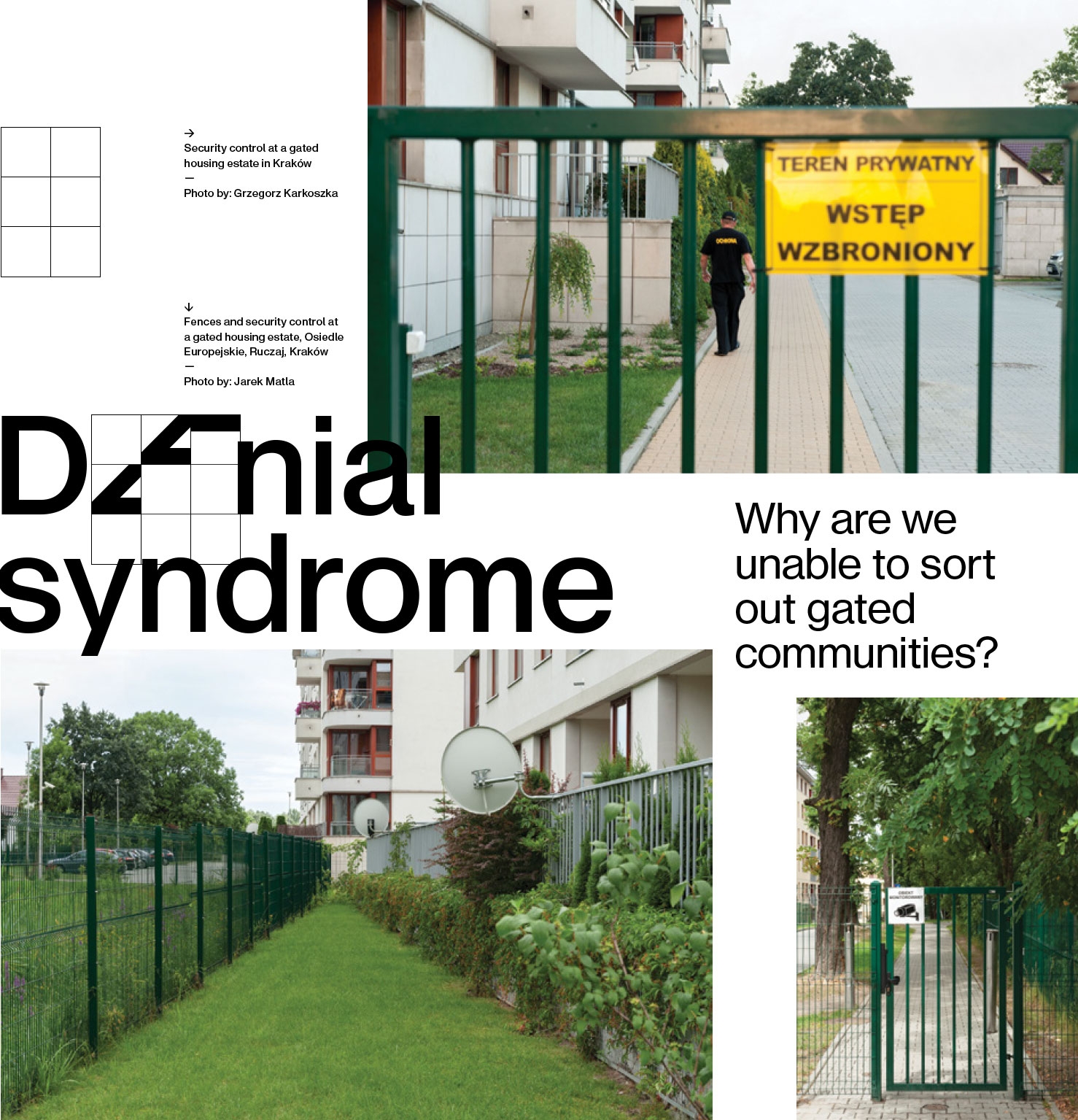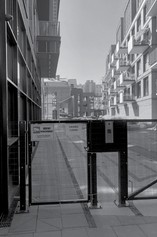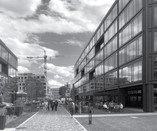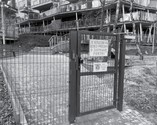The worst way of dealing with a problem is to pretend that it doesn’t exist. In psychology, this attitude is called denial, and it can lead to amnesia and numerous psychosomatic disorders. Gated communities are a symptom of denial in cities.
Since the end of the 1990s, the issue of gated communities has inflamed the milieu of people associated with urban issues in Poland. It was then that such housing estates first appeared in our country. The first Polish gated community was most probably an enclave of single-family houses, built in Piaseczno. Zbigniew Niemczycki, the real estate developer responsible for its construction, had returned from America not long before that. From overseas, he brought not only the idea for the estate being gated, but also for the houses – literally – to be put together from prefabricated elements.[1] The gated community debate has gone through the stages of curiosity, surprise, anxiety, indignation, and finally, it seems, a kind of resignation. An impasse was reached: the professional community agrees that it is a harmful phenomenon both from the point of view of space and the functioning of society, but this consensus does not translate into material reality.
Two themes dominate the discourse on gated communities: the spatial and the social; several others fit within their narrative. The spatial thread is simpler. Gated communities are “walled off or fenced off housing units with limited public access”[2]; and this thread analyses the degrees and methods of limiting access, and their impact on the surrounding space. We are talking about communication barriers,[3] about the disruption of urban continuity, but also about monotony and ugliness of fences and related inconvenience.
The social thread is much more ambiguous and it consists of many narratives. The first one connects the popularity of gated communities with the natural processes resulting from the political transformation and the transition from an inefficient socialized system to an idealized free market economy. According to this narrative, the reasons for fences include distrust in public institutions and the liberal belief held by the middle class that housing is a completely private affair.[4] In this narrative, a gated community becomes a synonym of resourcefulness and ennoblement.
The simplest explanation, often accepted intuitively and unreservedly, points to the feeling of danger or threat as the main basis for the decision to live behind closed gates. According to this – second – narrative, gated communities are a direct response to the need for security, one of the most important human needs. This point of view makes the fight against fences particularly difficult.
The individual narratives intertwine and overlap, and thus the second narrative turns into the third one – related to the commodification of fear, and then commodification in general. The fences and the system of protection, and finally a sense of security, are indicated in it as another commodity for sale (Zygmunt Bauman wrote about it in his Liquid Life: “marketing experts find the anxiety […] to be potentially inexhaustible source of profits”[5]), and because it is affected by market demand and supply mechanisms, it is subject to marketing efforts. Therefore, if it is profitable for business entities to sell flats in gated communities, they will tend to exaggerate the threats posed by the outside world in their advertisements and in public communications.
The fourth narrative changes the frame of fear into a frame of cooperation.[6] It emphasizes the intentional side of fences, and the opportunity they present for creating lively neighbourly communities whose members act for the common good, support each other, and strive for synergy. At this point, the narrative accompanying gated communities coincides with that of bottom-up housing initiatives, that is housing cooperatives and cohousing, and these are getting good press – much better than housing estates behind the gates. The fourth narrative implies the fifth one, which also concerns the community character of gated housing estates, although it points to the community as a tool of oppression. This narrative assumes the existence of intramural communities, but emphasizes their internal oppressive function of social control and external function of exclusion, based on a sense of elitism and the need for distinction.
At this point, the concept of social segregation appears, followed by yet another narrative. The phenomenon of gated communities development is called ghettoization. The word “ghetto”, although used in reverse, retains its pejorative connotations. It emphasizes the importance of gates, but not only in the sense of protection, but also compulsory enclosure, and the relativism of the fences – which always have two sides. This narrative presents gated communities as something shameful, out of fashion, and out of date. It results not so much from their extensive criticism as from the popularisation of the phenomenon. The popularity of gated communities has made it more difficult to buy a new apartment in an open housing estate than in a gated one, but at the same time the gated community has lost its ennobling and exclusive character. Besides, with its coarse fences, it does not resemble the most fashionable places in which to live today: functionally diversified residential and service complexes, typically embedded in the historic urban fabric. Elektrownia Powiśle (formerly a power plant) and Centrum Praskie Koneser (erstwhile vodka factory) in Warsaw manifest their elitism and exclusivity in much more subtle and tasteful ways. The excluding factor here is, on the one hand, the prohibitive price of flats, and on the other hand, hidden security and monitoring, which keep up appearances of a fashionable urban space, despite the fact that they offer none of the authentic urban openness and diversity. In this narrative, the criticism of gated communities, manifested in the contemptuous terms of “lemmings” and “transplants”,[7] is founded in the same resentment on which their elitism once stood.
Each of the narratives contains a different part of the truth about gated communities, and points to different parts of the problem, so it is no wonder that subsequent reactions to fencing off housing estates also match only selected narratives and subplots.
Seeking a legal solution
The spatial thread contains the idea of introducing local landscape resolutions. Pursuant to the Act of April 24, 2015 on the amendment of certain acts in connection with the strengthening of landscape protection tools, local governments may introduce their own local landscape regulations. As part of these regulations, under local law, decisions are made on advertising-free cultural parks, as well as on the prohibition of fencing off urban space. Resolutions explicitly prohibiting the fencing of multi-family residential areas were introduced in 2018 in Sosnowiec,[8] Sopot[9], and Gdańsk[10], and in 2020 in Kraków.[11] In Nowy Targ [12] and Cieszyn,[13] resolutions prohibit only full fences; in Katowice (March 2021), the resolution has not been adopted yet, despite the fact that work on it began in 2015, and in 2017 the proposed regulations were presented for public consultation. Also in Poznań, consultations are underway on the provisions of the resolution. Apparently, the draft supposedly prohibits the fencing of multi-family housing, but it allows so many exceptions that even if it comes into force, this will not change much.[14]
In January 2020, the councillors in the capital adopted the Warsaw landscape resolution, but in February 2020 it was completely repealed by the governor of the Masovia Province. The city filed a complaint against this decision, but in December of the same year the Regional Administrative Court in Warsaw dismissed it in closed hearing. Also the landscape resolutions of Łódź and Opole were repealed by court decisions, and an appeal was made against the resolution adopted in Gdańsk.
It turns out, therefore, that for almost six years there has been a tool that might have stopped the fencing of housing estates, but only a few municipalities have actually used it. Perhaps this solution is of low effectiveness, because it concerns only the spatial sphere, while completely ignoring the social aspect?
Enhancing security?
There are also other ways of dealing with gated communities that are only solutions within the chosen paradigm. When the housing estates behind the gates are seen through the prism of the second narrative – the one related to the need for security – architectural concepts that strengthen the sense of safety are proposed as an antidote. Most of them are based on Oscar Newman’s classical theory of defensible space. The latter contains the principles of arranging the housing estate in such a way as to prevent unwanted behaviour – theft, assaults, or acts of vandalism.[15] Newman recommends clear zoning of public, semi-public, and private spaces, providing conditions for observing all areas of the estate, and eliminating objects that could be used as steps in a ladder, thus allowing an intruder to climb to higher floors. In short: the spatial solutions proposed by Newman are meant to result in specific behaviours of the users.
On the basis of Newman’s theory, many programs were created, recommended by city planners and policemen,[16] including Secured by Design – the official program of the British police, and the CPTED program (Crime Prevention Through Environmental Design), which comes from the United States, widely promoted by the international non-governmental organization called the ICA (International CPTED Association)[17]. ICA led to the publication of the ISO standard on CPTED in January 2021 (ISO 22341:2021). Although the American version focuses on spatial issues, it also emphasizes the importance of a strong local community. In the second generation of CPTED rules (the first one contained spatial and technical solutions, also regarding access limitation), it was described, for example, how to organize a neighbourhood watch. It is difficult to shake off the impression that the proposed remedy may become a disease at some point. The problem was noticed, among others, by Bryan Lee Jr., a black designer from New Orleans who deals with the concept of ‘just city’. Lee believes that security mechanisms based on neighbourly control and the assumption that any person with antisocial intentions should feel uncomfortable may cause discomfort to anyone who looks different and does not conform to normative patterns or – what is particularly important in the United States – has a different coloured skin.[18] The strategy promoted by the CPTED threatens to deepen the divisions between “us” and “them” and reinforce the not-in-my-backyard phenomenon, i.e. the opposition of residents to certain investments (for example shelters for people experiencing homelessness crisis, or counselling centres for people with addictions) in their immediate vicinity, although they do not deny that these facilities are needed.
The concept of design influencing user behaviour can also lead to abuse. After all, this includes the controversial ‘hostile design’, i.e. elements used in public space that are supposed to modify human behaviour, for example, prevent the homeless from lying on park benches. It is difficult to precisely answer the question of when the applied elements help maintain security, and when they serve to divide and exclude.
Therefore, this solution cannot be considered effective either. Focusing on one narrative does not lead to obtaining answers to other narratives; worse, it provokes situations that, according to subsequent narratives, may be considered problematic. The effects of the criticism against the fencing of housing estates, based largely on the contempt for inhabitants of gated communities who want luxury and distinction, can be assessed in a similar way. It resulted (in a manner of speaking, because we should not ascribe excessive importance to that) in a new wave of antagonisms and reluctance towards yet another social group.
Diagnosis
To understand the problem of gated communities with all its complexity, no single narrative will suffice. In medicine, when a set of symptoms is not amenable to diagnosis or treatment, an explanation beyond purely physical issues is sought. As health problems can be a symptom of disease not only of the body, but also of the mental sphere, answers are sought in the patient’s personal life, in his relationships with his family and childhood memories, and uncomfortable truths are discovered. Perhaps, in a similar way, the problems of our cities result from the psychological problems of individuals and the society, and gated communities are merely a veil, the effect of the denial syndrome that breaks to the surface while hiding the thing that causes the unpleasant feelings, the thing we subconsciously do not want to look at, that does not fit into our vision of reality?
After all, there are many things we do not want to look at: places and people who will never fit into the perfect image of the city straight from Jan Gehl’s books, an inconvenient truth that does not fit in with our collective vision of an ideal city. Many elements hurt our eyes also in the housing sphere.
Firstly, the housing problem can never be fully resolved. It is impossible to arrange a city where there will be no substandard flats, which are too small, overcrowded, underexposed, and ugly, or a city where everyone will have access to the flat they need. Housing resources are degrading, the requirements, needs and possibilities of the entire society and individuals are changing, so even in cities where the statistical deficit of housing has been eliminated, a housing policy must be pursued. If we were to acknowledge that for housing, crisis is a natural condition, we would cease to perceive housing policy as an intervention. The housing estate would become a type of infrastructure, rather than a social policy; it would cease to be perceived in terms of charity or as something shameful. It would not be necessary to hide social flats on Dudziarska Street in Warsaw, or in metal containers on the outskirts of many cities in Poland.
Secondly, it is impossible to solve the problem of homelessness or to remove people in the homelessness crisis from the urban space. Some of these people will never be able to lead the life that the general public considers ‘normal’. Some will never wish to. This does not mean that night shelters should be closed; on the contrary – infrastructure for people experiencing a homelessness crisis should be made a rightful and equal element of the urban landscape. Night shelters should not be situated in the worst locations, and park benches should not discourage people from lying down. No worries, people will not take to sleeping in parks on a mass scale, the general public prefer the comfort of their beds.
Finland introduced the “home first” scheme, and has done so comprehensively. Within that scheme, any person in a homelessness crisis can obtain assisted housing, regardless of whether or not they will adapt to arbitrary rules. At the Congress of Urban Movements in Katowice in 2017, Hanna Gill-Piątek emphasized that within only three years, the costs generated for the city by a person in a homelessness crisis exceed the cost of building a small, basic apartment. Perhaps the Finnish method would help us bring the phenomenon of homelessness to the lowest possible level, and save a few people from dying in the street while we’re at it.
Thirdly, when we say that a city is its people, we cannot mean merely heteronormative families with two children, or middle-class members with internalized social norms. The real city is the young and the old, the poor and the rich, the smart and the stupid, the pretty and the ugly; exemplary citizens, but also troubled recidivists, vegans, cyclists and diesel SUV-driving pork-knuckle eaters. The city is made up of Catholics, Buddhists and followers of the Flying Spaghetti Monster, classical music lovers and disco polo fans, those who are pro-choice and those who are pro-life, and even the residents of gated communities.
Fourthly, city will never be completely safe, so instead of hiding our children behind a fence, let us teach them to minimize the risk.
Fifthly, not everywhere can be beautiful. Ugliness, dirt and mediocrity have the same or even greater right to the city space as cleanliness, beauty and harmony. Perhaps a centrally managed shopping mall can be truly clean, beautiful and harmonious – but a living city cannot.
I do not intend to psychoanalyze the city. There are authors, for example Andrzej Leder, who are better equipped to do that. I would like to point out that if a city (which also extends to ourselves – town planners and residents) wishes to solve the problem of gated communities, it must – to continue the psychological parallel – face the truth about itself: get rid of its idealized image, and in return begin to like itself the way it is, accept its imperfect but merely good enough elements.
What we need
We need an inclusive city that accepts its problems and solves them openly instead of being ashamed of them, ignoring them, and finally denying their existence. We need a city in which every resident, regardless of their status, gender, age, ethnic origin and any other characteristics, firstly, will find a place for themselves (in a general sense), and secondly, will find the conditions to secure a decent place to live. Citizens have the right to the city, and the right to housing. They have the right to use the city fairly, and to participate broadly in its governance, and in housing accessibility for all. That accessibility should be considered already at the stage of ensuring the conditions for the supply of housing, i.e. when establishing the framework for the city’s development, estimating the number and type of housing units needed, designating land for their construction, and planning technical and social infrastructure.
In practice, we need the percentages of flats in the accessible sector to be established for each area within the city limits, already at the level of local law. We need housing provisions through which social housing will be created next to commercial housing, indistinguishable from the outside, for example in accordance with the principles of ‘pepper potting’ (scattering social housing units among private housing) and ‘tenure blindness’ (meaning that from the outside, it is impossible to distinguish the status of the apartment). We need to coordinate the construction of new apartments with the infrastructure, not only technical, but also social where necessary, and the costs of that must be passed on to real estate developers. We need to start treating property also as an obligation, and not just as an unlimited right.
We need a holistic paradigm shift. If it happens, perhaps gated communities will not be needed anymore. However, if any do appear, we will include them in the urban landscape and accept them.













